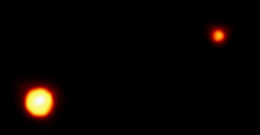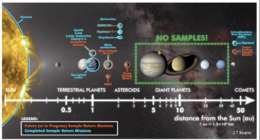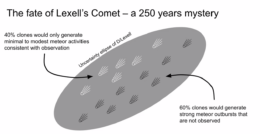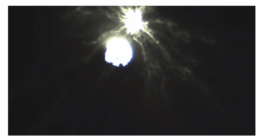Editor’s Note: This week we’ll be writing updates on selected events at the 55th Division for Planetary Sciences (DPS) meeting, held jointly with the Europlanet Science Congress (EPSC) in San Antonio, Texas, and online. The usual posting schedule for AAS Nova will resume on October 9th.
Table of Contents:
- Kuiper Prize Lecture: Some Problems and Challenges in the Origin and Evolution of Icy Satellites and Dwarf Planets (William McKinnon)
- Urey Prize Lecture: Exploring Asteroids and Comets with Meteor Science (Quanzhi Ye)
- The Double Asteroid Redirection Test (DART): One Year After Impact (Cristina Thomas)
- Planetary Defense: DART & LICIACube (Elisabetta Dotto)
Kuiper Prize Lecture: Some Problems and Challenges in the Origin and Evolution of Icy Satellites and Dwarf Planets (William McKinnon)

Our best view of Pluto and Charon as of 1994, taken with the Hubble Space Telescope. [Dr. R. Albrecht, ESA/ESO Space Telescope European Coordinating Facility; NASA; CC BY 4.0]
The post-Voyager era brought about the beginning of a lengthy quest to get a mission to Pluto off the ground. That mission, New Horizons, eventually launched in 2006 and flew past Pluto in 2015, the observations exceeding McKinnon’s expectations “by an order of magnitude.” The second major milestone of the mission, a flyby of the Kuiper Belt object Arrokoth, was perhaps even more astounding, giving us the first look at a nearly pristine primordial object left over from the formation of the solar system.
In addition to major missions like New Horizons, the 21st century brought new models to explain how our solar system came to be as it is: the Nice model, which describes how the migration of the giant planets generated structures like the Kuiper Belt and triggered events like the Late Heavy Bombardment; the streaming instability/pebble accretion models, which explain how tiny grains might bulk up into planetesimals and eventually planets; and the great isotopic dichotomy, in which the growth of Jupiter’s core opened a gap in the disk of material in which the planets formed, restricting movement of material across this gap.

Collecting material from the icy satellites of the outer solar system is a missing piece in our sample return collection. Click to enlarge. [Slide by William McKinnon]
Urey Prize Lecture: Exploring Asteroids and Comets with Meteor Science (Quanzhi Ye)
The 2023 Harold C. Urey Prize, awarded annually to an early-career planetary scientist in recognition of their outstanding achievements, went to Quanzhi Ye (University of Maryland) for his studies of asteroids and comets. Humans have kept track of comets and meteor showers for millennia, as evidenced by drawings from more than two thousand years ago. The connection between meteor showers and comets was realized in the 1800s, and as we’ve discovered more and more meteor showers, we’ve needed to develop sophisticated mathematical methods to connect these events to the comets that created them.

Graphic demonstrating how the lack of a meteor shower associated with D/Lexell helped researchers track down the comet’s current location. [Slide by Quanzhi Ye]
Studying the meteors themselves as they streak through Earth’s atmosphere can also help us learn about the objects they came from. For example, the altitude at which a chunk of material becomes luminous as it travels through the atmosphere is related to its material strength; meteorites that become luminous high up have low material strength and tend to come from comets, while those that become luminous lower down have high material strength and tend to come from asteroids. Ultimately, researchers have a wealth of dynamical, compositional, and physical measurements that can be used to study meteor parent bodies, and an expanding global network of telescopes used for meteor studies will provide new opportunities for study as well.
The Double Asteroid Redirection Test (DART): One Year After Impact (Cristina Thomas)
Cristina Thomas (Northern Arizona University) described what we’ve learned from the DART mission in the year since impact. The DART mission’s target was a binary asteroid system consisting of Didymos, which is less than a kilometer in diameter, and its small companion Dimorphos, which is just 150 meters across. The goal of the mission was to crash a spacecraft into Dimorphos, change the orbital period of the binary, measure the change in the orbital period, and then characterize the impact and the impact site. These results can tell us how useful crashing a spacecraft into an oncoming asteroid would be as a planetary defense strategy.

Observations showing how Dimorphos’s orbital period changed as a result of the impact. Click to enlarge. [Slide by Cristina Thomas]
Our studies of the impact of the DART mission are far from over; Thomas notes that there will be another observing campaign in 2024 to study the ongoing evolution of Dimorphos’s orbit, and the European Space Agency’s Hera mission will study the aftermath further. This mission, slated for launch in 2024 and arrival in 2026, will perform a detailed study of Dimorphos, helping us to understand the details of the asteroid-impact technique for planetary defense as well as allowing us to investigate a binary asteroid system.

